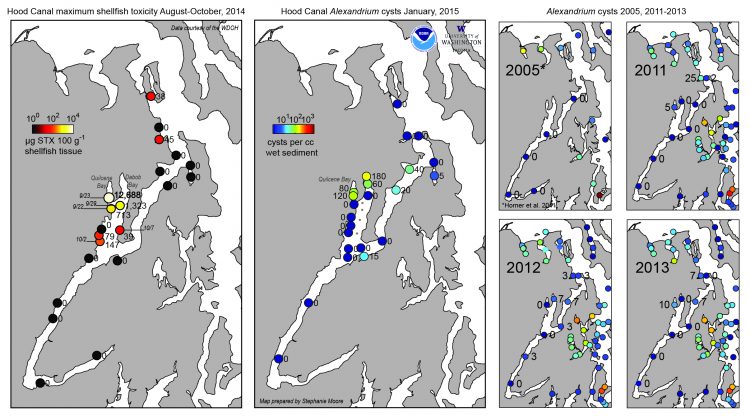An unprecedented bloom of the harmful alga Alexandrium occurred during Fall 2014 in Quilcene Bay, Hood Canal, Puget Sound, WA; the outbreak contaminated shellfish with potent biotoxins that can cause paralytic shellfish poisoning. The area of the bloom was historically biotoxin free, but at the peak of the event, the Washington State Department of Health detected toxin in shellfish over 100 times the regulatory limit for human consumption.
Species of the harmful alga Alexandrium produce dormant cysts that overwinter in bottom sediments on the seafloor. The following season the cysts germinate, creating more blooms. Concerned that the Quilcene Bay bloom formed a new “seed bed” (i.e., a concentrated area of cysts in bottom sediments) increasing summer bloom risk this year, NCCOS sponsored scientists on the Puget Sound Alexandrium Harmful Algal Blooms project (PS-AHAB) initiated an emergency cyst mapping effort January 17-20, 2015. The work was supported in part by the NCCOS ECOHAB Program and Penn Cove Shellfish, LLC.
Previous harmful algal cyst mapping efforts found zero or very low concentrations of bloom area cysts. The highest concentration observed was 10 cysts per cubic centimeter (cc) wet sediment in Quilcene Bay in 2013. In 2015, PS-AHAB scientists found a magnitude greater concentration of cysts than in 2013. To disseminate the results outreach strategies included phone calls to area shellfish growers, e-mails to state managers and others, a presentation at the 22nd Washington Shellfish Growers Association Meeting, blogs, and postings to the PS-AHAB website.

So far, no direct relationship exists between locations with high cyst abundances and shellfish toxicity in Puget Sound, and the number of cysts required to initiate a bloom is undetermined. These questions and others form the basis of the PS-AHAB research. Results warrant increased vigilance for monitoring cells and toxins during the 2015 season and beyond in this area. As an example, based on the cyst mapping, Washington State Department of Health closed recreational shellfish harvesting in the Quilcene Bay and Dabob Bay areas of Hood Canal in the Spring of 2015.
For more information, contact Quay.Dortch@noaa.gov.
